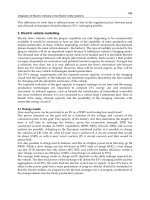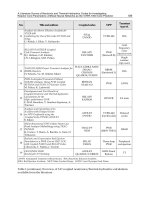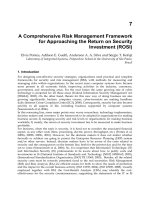The Analysis of Firms and Employees Part 9 pptx
Bạn đang xem bản rút gọn của tài liệu. Xem và tải ngay bản đầy đủ của tài liệu tại đây (335.48 KB, 42 trang )
4
Globalization, Trade,
and Labor Markets9.1 Introduction
Linked employer-employee data are uniquely suited to document labor-
market responses to economic reform. While the formation of multina-
tional enterprises shapes much of the globalization debate over labor-
market consequences in industrialized countries (see chapter 10), an issue
of foremost importance for developing countries is the labor-market
impact of trade reform. The present chapter investigates Brazil’s labor
demand changes following its large-scale trade liberalization in the early
1990s. Measures of labor-demand change document that the workforce
in Brazil’s traded-goods sector simultaneously undergoes an occupation
downgrading and an education upgrading. This workforce changeover is
broadly consistent with Heckscher-Ohlin-style trade theory for a low-skill
abundant economy, whose low-skill intensive activities are predicted to ex-
pand and absorb larger shares of skilled workers to maintain full employ-
ment. Tracking workers across their jobs within establishments, across es-
tablishments within industries, and across firm types and industries within
Brazil’s formal sector, documents how employers achieve the observed
workforce changeover. The reallocation pattern is not what premises of
classic trade theory imply: among the displaced workers with a successful
reallocation, most shift to nontraded-output industries—but almost as
269
9
Trade and Workforce
Changeover in Brazil
Marc-Andreas Muendler
Marc-Andreas Muendler is an assistant professor of economics at the University of Cali-
fornia, San Diego, and a faculty research fellow at the NBER.
I thank conference participants at CAFE 2006 in Nuremberg, and Lars Vilhuber and Julia
Lane, in particular, for helpful suggestions. I thank Jennifer Poole for dedicated research as-
sistance. I gratefully acknowledge financial support from the NSF under grant SES-0550699
and the Alfred P. Sloan Foundation.
many displaced workers do not find formal reemployment at an annual
horizon.
The linked employer-employee data source is RAIS (Relação Anual de
Informações Sociais), a comprehensive register of workers formally em-
ployed in any sector in Brazil (including the public sector). The database is
used to administer Brazil’s federal minimum-wage supplement program
and is shared across statistical agencies. RAIS offers information on worker
characteristics such as age, gender, education, and job characteristics, in-
cluding the wage, dates of hiring and separation, and a detailed occupa-
tional classification that permits inferences about the skill level of jobs. In
this chapter, attention is limited to prime-age workers past their first entry
into the active labor force and to male workers, because male workers are
known to exhibit relatively low labor-supply elasticities.
1
The data are com-
plemented with firm-level information on export status and sector-level in-
formation on economic reforms.
Much emphasis in the literature on job creation and destruction is placed
on churning: gross job creation and destruction at shrinking or expanding
employers beyond their observed net employment changes. Churning is a
particular aspect of the reallocation process and, from a worker’s perspec-
tive, is mostly associated with the part of job spells that are not necessarily
related to ultimate reallocations across activities. By definition, churning is
an employer-level phenomenon. This chapter shifts the focus from the em-
ployer to the individual worker and documents several worker-related as-
pects of the reallocation process. The importance of churning and excess
turnover in the reallocation process notwithstanding, a paramount effi-
ciency concern for the performance of labor markets is the ultimate reas-
signment of workers to new activities.
Brazil exhibits a shift toward low-skill intensive economic activities fol-
lowing trade reform. For the least-skilled illiterate workers and primary
school dropouts, the long-term trend of dropping demand is strongly re-
versed during the time of trade liberalization, and results in a net labor-
demand increase through 2001. For college graduates at the upper end of
the skill range, demand surges before and after liberalization, especially in
the nontraded sector, are so strong that the drop in their demand during
trade liberalization weighs little; a net demand increase prevails through
2001. Intermediate education groups suffer a demand decline in the traded-
goods industries that more than outweighs their moderate demand in-
crease in the nontraded sector. A Katz and Murphy (1992) decomposition
into between-industry and within-industry changes shows that a large part
of the overall evolution is predicted by these between-industry changes.
But there is also a substantial workforce changeover within industries and
across occupations.
270 Marc-Andreas Muendler
1. Statistics are similar in the overall nationwide sample. Statistics and estimates on the
overall sample and alternative subsamples are available from URL econ.ucsd.edu/muendler.
Measuring jobholders’ years of schooling by occupation, and subtract-
ing the mean years of schooling across all occupations, shows a continuous
and steady increase in net schooling intensity across all occupations in the
traded-goods sector between 1990 and 2001. This workforce changeover is
associated with employment shifts from high- to low-skill intensive occu-
pations, while employers simultaneously fill the low-skill-intensive occupa-
tions with more and more educated jobholders. Both processes, occupation
downgrading and education upgrading, are reminiscent of an interpre-
tation of the Heckscher-Ohlin argument applied to occupational activities
(instead of industries). Given Brazil’s relatively low-skill abundant labor
force, a Heckscher-Ohlin style argument would posit that Brazil increas-
ingly specializes in less schooling-intensive occupations but that the traded-
goods sector employs in these expanding low-skill occupations relatively
more high-skilled workers while their relative wage declines by the Stolper-
Samuelson theorem.
Among several economic reforms—including macroeconomic stabiliza-
tion, privatization, and some capital-account liberalization—the trade lib-
eralization program of 1990 played a dominant role for labor-market out-
comes. In multivariate regressions at the establishment level, I control for
employer-fixed and year effects as well as various variables related to eco-
nomic reforms and find that an employer’s export status, along with sec-
toral tariff protection levels, exhibits the most predictive power for em-
ployment changes. Trade-related interpretations of labor-demand changes
are, therefore, emphasized.
Beyond conventional labor-demand analysis, the comprehensive linked
employer-employee data for Brazil’s economy as a whole permit the track-
ing of individual workers across occupations, establishments, firm types,
and industries in Brazil’s formal sector. There is no evidence that employers
reallocate workers across tasks in-house in response to trade reform. The
share of in-house job transitions is constant over time, and minor. Surpris-
ingly, there is also little evidence that the economy reallocates workers
across firms and industries. Trade theory would lead us to expect a shift of
displaced workers from nonexporting firms to exporters, following trade
reform. The dominant share of successful reallocations within the traded-
goods sector is to nonexporters, however, and this share is dwarfed by re-
allocations to nontraded-output industries. An equally large share of dis-
placed workers, around a third, finds no formal-sector reemployment at the
annual horizon. Taken together, these findings imply that employers pursue
the observed workforce changeover by laying off relatively less-skilled
workers, especially from skill-intensive occupation categories. This form of
workforce changeover following trade reform is potentially associated with
important adjustment costs to the economy. It remains a task for future re-
search to analyze the impact of economic reform on worker separations, ac-
cessions, and spell durations outside formal-sector employment.
In line with the descriptive evidence, but in contrast to what general-
Trade and Workforce Changeover in Brazil 271
equilibrium trade models with full employment might lead us to expect, a
firm’s export status predicts significant job losses. There is no conclusive
evidence, however, that exporting status is causally related to employment
reductions. When firm-level export status and its interaction with product-
market tariffs are instrumented with sector-year varying foreign compo-
nents of the real exchange rate, export status loses its statistical signifi-
cance. This addresses the possible importance of employer-level workforce
heterogeneity and suggests the construction of worker-level hiring and fir-
ing samples in future research.
While there are only slight differences between metropolitan areas and
the nationwide average regarding employer characteristics and the sectoral
composition of the labor market, metropolitan labor markets exhibit a
markedly faster reallocation success. During the sample period, almost two
in three successfully reallocated workers in metropolitan areas find a new
job within the month of their separation. In contrast, only one in seven re-
allocated workers nationwide is rehired within the same month of displace-
ment. In metropolitan areas, 95 percent of the successfully reallocated
workers start their new job within twelve months. But only 77 percent of
the successfully reallocated workers nationwide find new employment
within a year. These stark differences in labor-market performance could
be partly due to the slightly more diverse size distribution or the more var-
ied workforce composition of employers in metropolitan areas, or to the
somewhat larger nontraded-output sector in metropolitan areas. Further
investigations are called for to improve our understanding of the labor-
market specific differences in the reallocation process.
In related studies to examine the effects of trade liberalization on em-
ployment, Revenga (1992, 1997) finds that import competition reduces net
employment at the sector level in the United States and Mexico. Mean-
while, a large part of the literature adopts the Davis, Haltiwanger, and
Schuh (1996) approach of generating gross job flow statistics by industry
and year and regressing those statistics on measures of trade exposure and
exchange rates. In that line of research, Roberts (1996), for instance, does
not find a strong effect of trade exposure on gross employment flows in
Chile and Colombia, once industry characteristics are taken into account.
Neither do Davis, Haltiwanger, and Schuh (1996) identify a clear effect of
trade on factor reallocation using U.S. data. However, studies that consider
exchange rate effects beyond trade exposure, such as Gourinchas (1999) or
Klein, Schuh, and Triest (2003), do find systematic effects on employment
flows. Klein, Scott, and Schuh (2003) find for the United States that job
destruction, churning, and net employment growth respond to exchange
rate movements, while job creation is unresponsive. In the Brazilian case,
Ribeiro et al. (2004) compute industry-level rates of job creation and de-
struction and find that greater openness reduces employment through in-
creased job destruction, with no effects on job creation, and that exchange
272 Marc-Andreas Muendler
rate depreciation increases job creation with no effect on job destruction.
Haltiwanger et al. (2004) use a panel of industries in six Latin American
countries and report that a reduction in tariffs and exchange rate appreci-
ations increase job reallocation within sectors and that net employment
growth tends to decline as trade exposure rises. In contrast to the lacking
evidence on an association between trade exposure and labor-market out-
comes in much of the earlier literature, a firm-level indicator of exporting
status in the employer regressions of this chapter shows a highly significant
relationship between exporting status and employment reductions during
a period of trade reform, and a more pronounced association in less tariff-
protected sectors. Beyond the prior literature, the linked employer-
employee data of this paper permit the tracking of workers across activi-
ties, employers, and industries, and document these novel aspects of the
labor-market response to trade reform.
The remainder of this chapter is organized in six more sections. Section
9.2 describes the main linked employer-employee data source as well as
complementary firm and sector data, while details are relegated to the Ap-
pendix. Section 9.3 presents labor demand changes over the sample period
1986–2001, discerns between-sector and within-sector changes using a
Katz and Murphy (1992) labor demand decomposition, and documents
the workforce changeover within sectors along educational and occupa-
tional dimensions. Section 9.4 investigates how much of the documented
workforce changeover is brought about by task reassignments within
firms, worker reallocations across firms and industries, and by worker sep-
arations without formal-sector reallocations. Multivariate regressions in
section 9.5 document the predictive power of exports and trade-related re-
gressors compared to competing employer and sector variables. Section
9.6 looks into labor-market performance as measured by time to success-
ful reallocation. Section 9.7 concludes.
9.2 Linked Employer-Employee Data
Workers of particular concern for the labor-market restructuring process
are prime-age male workers, who typically show a low labor-supply elastic-
ity. Most of the evidence of this chapter nevertheless applies to workers
across gender and age groups. My restriction to prime age (25 to 64 years)
serves to capture workers past their first entry into the active labor force.
Beyond a 1 percent nationwide random sample of prime-age male workers,
a five-percent metropolitan random sample of prime-age male workers is
used to assess regional differences in labor-market outcomes.
The linked employer-employee data derive from Brazil’s labor force
records, RAIS (Relação Anual de Informações Sociais, of the Brazilian la-
bor ministry MTE). RAIS is a nationwide, comprehensive annual record
of workers formally employed in any sector (including the public sector).
Trade and Workforce Changeover in Brazil 273
RAIS covers, by law, all formally employed workers, captures formal-
sector migrants,
2
and tracks the workers over time. By design, however,
workers with no current formal-sector employment are not in RAIS.
RAIS primarily provides information to a federal wage supplement pro-
gram (Abono Salarial), by which every worker with formal employment
during the calendar year receives the equivalent of a monthly minimum
wage. RAIS records are then shared across government agencies and sta-
tistical offices. An employer’s failure to report complete workforce infor-
mation can, in principle, result in fines proportional to the workforce size,
but fines are rarely issued. In practice, workers and employers have strong
incentives to ascertain complete RAIS records, because payment of the an-
nual public wage supplement is based exclusively on RAIS. The ministry of
labor estimates that well above 90 percent of all formally employed work-
ers in Brazil were covered in RAIS throughout the 1990s.
The full data include 71.1 million workers (with 556.3 million job spells)
at 5.52 million establishments in 3.75 million firms over the sixteen-year
period 1986–2001. Every observation is identified by the worker ID (PIS),
the establishment ID (of which the firm ID is a systematic part), the month
of accession, and the month of separation. Relevant worker information
includes tenure at the establishment, age, gender, and educational attain-
ment. Job information includes occupation and the monthly average wage;
establishment information includes sector and municipality classifica-
tions. To facilitate tracking, RAIS reports formal retirements and deaths
on the job. RAIS identifies the establishment and its firm, which in turn can
be linked to firm information from outside sources such as export data.
This chapter’s sample derives from a list of all proper worker IDs (11-
digit PIS) that ever appear in RAIS at the national level, from which a 1
percent nationwide random sample of the IDs and a 5 percent metropoli-
tan random sample was drawn, and tracks the selected workers through
all their formal jobs. Industry information is based on the subsector IBGE
classification (roughly comparable to the NAICS three-digit level), which
is available by establishment over the full period (see table 9.10 for sector
classifications). For the calculation of separation and reallocation statis-
tics, a worker’s separation is defined as the layoff or quit from the highest-
paying job.
3
274 Marc-Andreas Muendler
2. Migration among metropolitan workers is substantial. Among the prime-age male work-
ers in RAIS with a metropolitan job in 1990, for instance, 15 percent have a formal job out-
side the 1990 city of employment by 1991 and 25 percent by 1993. Similarly, among the met-
ropolitan workers in 1994, 17 percent have a formal job elsewhere by 1995 and 27 percent by
1997.
3. Among the male prime-age workers nationwide, 3 percent of the job observations are si-
multaneous secondary jobs. Tables 9.3, 9.4, 9.5, and 9.9 are based on the so-restricted sample,
whereas all aggregate statistics, Katz-Murphy decompositions, and regressions are based on
the full sample. The restriction to a single job at any moment in time permits a precise defini-
tion of job separation as a layoff or quit from the highest-paying job (randomly dropping sec-
Table 9.1 shows the allocation of workers across industries in 1990 and
1997 (a detailed employment-share breakdown for the RAIS universe can
be found in table 9.10). The nationwide RAIS records represent almost 23
million formally employed workers of any gender and age in 1990, and
more than 24 million formal workers in 1997. The bulk of Brazil’s formal
employment is in manufacturing, services, and other industries (which in-
clude construction, utilities, and the public sector), with roughly similar
formal employment shares between a quarter and a third of the overall for-
mal labor force. Commerce (wholesale and retail) employs around one in
eight workers, and the primary sector (agriculture and mining) at most one
in twenty-five formal workers.
Prime-age male workers nationwide make up slightly less than half of the
total workforce in 1990 and 1997. In both years, prime-age male workers
are slightly more frequently employed in the primary and manufacturing
sector than the average worker of any gender and age, but less frequently
in commerce, services, and other sectors. More than half of the RAIS-
reported formal employment of prime-age males occurs in the six metro-
Trade and Workforce Changeover in Brazil 275
ondary jobs if there is a pay tie). Removing simultaneously held jobs does not significantly
affect estimates of skill, occupation, and gender premia in Mincer (1974) regressions
(Menezes-Filho, Muendler, and Ramey, 2008).
Table 9.1 Employment by employer’s sector and export status
Traded goods
Nontraded output
Primary Manuf. Comm. Services Other Overall
a
(1) (2) (3) (4) (5) (6)
Allocation of workers, nationwide
1990 .021 .238 .128 .280 .333 22,844
1997 .044 .195 .152 .320 .289 24,068
Allocation of prime-age male workers, nationwide
1990 .029 .263 .111 .284 .314 10,763
1997 .063 .221 .131 .308 .278 11,483
Nonexporter .882 .494 .935 .937 .930 .830
Exporter .118 .506 .065 .063 .070 .170
Allocation of prime-age male workers, metropolitan areas
1990 .015 .270 .104 .309 .302 5,965
1997 .024 .213 .125 .363 .275 6,060
Nonexporter .760 .390 .887 .913 .898 .778
Exporter .240 .610 .113 .087 .102 .222
Note:
a
Total employment (thousands of workers), scaled to population equivalent.
Sources: RAIS 1990–2001, employment on December 31, and SECEX 1990–2001. Nation-
wide information based on 1% random sample, metropolitan information on 5% random
sample. Period mean of exporter and nonexporter workforces, 1990–2001.
politan areas of Brazil: São Paulo city, Rio de Janeiro city, Belo Horizonte,
Porto Alegre, Salvador, and Recife. Compared to the nationwide average
across gender and age, prime-age males in metropolitan areas are slightly
less frequently employed in the primary sector, commerce, and other sec-
tors, and somewhat more frequently employed in manufacturing and ser-
vices. Overall, however, the labor allocation across sectors is broadly simi-
lar across regions and gender and age groups, whereas changes over time
between 1990 and 1997 are more pronounced. Between 1990 and 1997,
there is a marked drop in formal manufacturing employment, which is ac-
companied by an increase of employment in primary sectors, commerce,
and especially services. Overall, between roughly a quarter and a third of
the nationwide and metropolitan prime-age male workforces are employed
in traded-goods sectors, and two thirds to three quarters in nontraded-
output sectors.
9.2.1 Complementary Firm-Level Export Data
At the firm level, annual customs office records from SECEX (Secretaria
de Comércio Exterior) for 1990 through 1998 are used to infer an indica-
tor variable for a firm’s exporting status, which is set to 1 when SECEX re-
ports exports of any product of any value from the firm in a given year. The
export-status indicator is linked to RAIS at the firm level. SECEX includes
merchandize shipments, but not services exports. National accounting
data suggest that, during the 1990s, Brazilian services exports were of mi-
nor importance.
Table 9.1 shows the allocation of prime-age male employment by ex-
porting status of the employer, and by sector, for the period from 1990 to
2001. Whereas nationwide only 17 percent of prime-age males work at ex-
porters, that share is 22 percent in metropolitan areas. Not surprisingly, the
largest share of prime-age male employment at exporters occurs in the
manufacturing sector, with more than 50 percent of the sector’s workforce
nationwide and over 60 percent in metropolitan areas. Primary-goods pro-
ducers in agriculture and mining employ only 12 percent (nationwide) and
24 percent (metropolitan) of the sector’s workforce—possibly because
some of their exports, especially in agriculture, are channelled through
commercial intermediaries. My focus, therefore, lies on the manufacturing
industries in the traded-goods sector. Occasional merchandize shipments
also occur among the commercial, services, and other-sector firms (con-
struction, utilities, and the public sector).
4
These firms have employment
276 Marc-Andreas Muendler
4. Recall that the export indicator is set to 1 when SECEX reports an export shipment of
any product of any value at the firm. Among the retailers and wholesalers in commerce are
some specialized import-export intermediaries who employ around 7 percent of the nation-
wide workforce. Shipments of accessory equipment in services and construction are consid-
ered merchandize exports by law, but the SECEX data show the sales value of these exports
to be expectedly minor. The main business of services and utilities firms is not merchandize
sale, so that the recorded employment shares at those firms do not imply that their employees
typically handle export merchandize.









